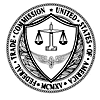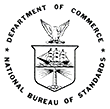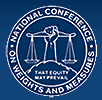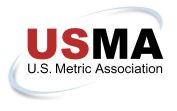Aside from “SI,” there aren’t really any metric acronyms, but there are a lot of acronyms you might run across when reading about SI. Here are some of them.
Note that there is a distinction between acronyms, initialisms, and abbreviations.
- An acronym is composed of the initial letters or parts of a compound term. It is usually read or spoken as a single word, rather than letter by letter. Examples: ANSI, NIST.
- An initialism is also composed of the initial letters or parts of a compound term, but is generally verbalized letter by letter, rather than as a single “word.” Examples: ASTM, FTC.
- An abbreviation is a shortened form of a word or words that does not follow the formation of either of the above. In American English, abbreviations usually include a period, but in British English, the period is generally omitted if the abbreviation omits letters within, rather than at the end of, a word: “Mr. Jones” in American, “Mr Jones” in British.
Jump to:
A B C D E F G H I J K L M N O P Q R S T U V W X Y Z
AESC — American Engineering Standards Committee, an old name for ANSI; read ANSI’s historical overview.

ANMC — American National Metric Council, a not-for-profit trade association founded in 1973 by private industry to assist companies in the metric transition process. See the USMA’s history of the American National Metric Council.

ANSI — American National Standards Institute, “a private, non-profit organization that administers and coordinates the U.S. voluntary standardization and conformity assessment system.” ANSI is the official U.S. representative on international standards bodies; it also makes copies of international standards readily available in the U.S. For the history of ANSI’s earlier names, such as the ASA, read ANSI’s historical overview. See also www.ansi.org
ASA — American Standards Association, an old name for ANSI; read ANSI’s historical overview.

ASTM — originally American Society for Testing and Materials but now officially named ASTM International, “one of the largest voluntary standards development organizations in the world” that provides “technical standards for materials, products, systems, and services.” One of the co-sponsors of IEEE/ASTM SI 10-2002, American National Standard for Use of the International System of Units (SI): The Modern Metric System. See also www.astm.org
B
BIML — Bureau International de Métrologie Légale, the Secretariat and Headquarters of the OIML. Here’s more about the BIML.

BIPM — Bureau International des Poids et Mesures, the International Bureau of Weights and Measures, created in 1875 by the Meter Convention (also known as the Treaty of the Meter, among other names) to provide the basis for a single, coherent system of measurements throughout the world, traceable to (what later became) the International System of Units. See also www.bipm.org
C
CAMS — Certified Advanced Metrication Specialist, USMA certification of an individual’s knowledge of SI and ability to use SI in engineering/scientific/technical areas. See also CMS, LCAMS, LCMS.
CCU — Consultative Committee on Units, a BIPM committee that deals with “matters related to the development of the International System of Units (SI), preparation of successive editions of the SI brochure, and advice to the CIPM on matters concerning units of measurement.” See also www.bipm.org/en/committees/cc/ccu/
CGPM — Conférence Générale des Poids et Mesures, the General Conference on Weights and Measures, created in 1875 by the Meter Convention (also known as the Treaty of the Meter, among other names) to supervise the CIPM. See alsohttp://www.bipm.org/en/worldwide-metrology/cgpm/
CGS — Centimeter-Gram-Second, an obsolete form of the metric system that was based on those three base units.
CIPM — Comité International des Poids et Mesures, the International Committee for Weights and Measures, created in 1875 by the Meter Convention (also known as the Treaty of the Meter, among other names), composed of delegates from various nations to supervise the BIPM. See also www.bipm.org/en/committees/cipm/
CMA — Canadian Metric Association. See the CMA.
CMS — Certified Metrication Specialist, USMA certification of an individual’s knowledge of common SI units and their correct use. See also CAMS, LCAMS, LCMS.

CODATA — Committee on Data for Science and Technology. Among other things, CODATA periodically publishes the recommended values for various physical constants. In the future, some of these constants might be defined rather than measured, and used in the definitions of SI base units, much like the constant c, the speed of light, once was a measured value but in 1983 was defined as 299 792 458 m/s (exactly) and used to define the length of the meter.
F

FDA — Food and Drug Administration, part of the U.S. Department of Health and Human Services, responsible for (among other things) labelling requirements for food and drugs sold in the U.S. For details, see the USMA’s page on regulations implementing the FPLA. See also www.fda.gov

FHWA — Federal Highway Administration, part of the U.S. Department of Transportation, involved in issues related to the use of the metric system in road construction and road signs. See also www.fhwa.dot.gov
FMVSS — Federal Motor Vehicle Safety Standard, one of a set of regulations issued by NHTSA. The one most relevant to the topic of metrication is FMVSS No. 101, Controls and Displays, which covers requirements for speedometers and odometers.
FPLA — Fair Packaging and Labeling Act, the U.S. law that, among other things, determines requirements for units used in quantity statements on packages sold to consumers in the U.S. For details, read the USMA’s page on the FPLA.

FTC — Federal Trade Commission, part of the U.S. Department of Commerce, responsible for (among other things) labelling requirements for many items sold to consumers in the U.S. For details, see the USMA’s page onregulations implementing the FPLA. See also www.ftc.gov
I
ICMP — Interagency Council on Metric Policy (prior to 1990 named the Interagency Committee on Metric Policy), providing guidance on the U.S. government’s transition to use of the metric system. See the Metric Conversion Policy for Federal Agencies. See also MOC.

IEC — International Electrotechnical Commission, an organization providing “international standards and conformity assessment for government, business and society for all electrical, electronic and related technologies.” See also www.iec.ch

IEEE — Institute of Electrical and Electronics Engineers, “a leading authority on areas ranging from aerospace systems, computers and telecommunications to biomedical engineering, electric power and consumer electronics among others.” One of the co-sponsors of IEEE/ASTM SI 10-2002, American National Standard for Use of the International System of Units (SI): The Modern Metric System. See also www.ieee.org

IERS — International Earth Rotation and Reference Systems Service. “Established in 1987 by the International Astronomical Union and the International Union of Geodesy and Geophysics, … IERS provides data on Earth orientation, on the International Celestial Reference System/Frame, on the International Terrestrial Reference System/Frame, and on geophysical fluids.” In particular, by keeping track of Earth’s rotation rate, IERS determines the need for leap seconds in the UTC time scale. See also www.iers.org

ISO — International Organization for Standardization, “a network of the national standards institutes of 160 countries, on the basis of one member per country,” “the world’s largest developer of standards.” Note that ISO is not an acronym but is from the Greek word ϊσος — transliterated “isos,” meaning “equal” — and is the organization’s short name in all languages, pronounced “eye-so” (not “eye-ess-oh”). See also www.iso.org

ITU — International Telecommunication Union, “the UN agency for information and communication technologies.” ITU-R, the Radiocommunication Sector, is responsible for the definition of the UTC time scale; in particular, they will ultimately decide whether to change the way leap seconds affect UTC. See also www.itu.int
L
LCAMS — Lifetime Certified Advanced Metrication Specialist, the lifetime recertification of the USMA certification of an individual’s knowledge of SI and ability to use SI in engineering/scientific/technical areas. See also CAMS, CMS, LCMS.
LCMS — Lifetime Certified Metrication Specialist, the lifetime recertification of the USMA certification of an individual’s knowledge of common SI units and their correct use. See also CAMS, CMS, LCAMS.
M
MKS — Meter-Kilogram-Second, an obsolete version of the metric system that was based on those three base units. MKSA was a variation that added the ampere as a fourth base unit.
MOC — Metrication Operating Committee, a committee consisting of a representative from each U.S. government agency. See the Metric Conversion Policy for Federal Agencies. See also ICMP.

MUTCD — Manual on Uniform Traffic Control Devices, an FHWA publication that regulates traffic lights, signs, and pavement markings in the U.S. See the USMA’s page on the MUTCD and metric road signs in the U.S.
N

NBS — National Bureau of Standards, the former name of NIST (q.v.) from 1901–1903 and 1934–1988.

NCSL — originally National Conference of Standards Laboratories but now officially named NCSL International, “was formed in 1961 to promote cooperative efforts for solving the common problems faced by measurement laboratories.” See also www.ncsli.org
NCSM — National Council on State Metrication, an organization of state government representatives. The USMB hosted some NCSM meetings; see the NCSM section of the USMB history.

NCTM — National Council of Teachers of Mathematics, “the world’s largest mathematics education organization.” NCTM is a co-sponsor of National Metric Week along with the USMA. See also www.nctm.org

NCWM — National Conference on Weights and Measures is a U.S. organization that “sets standards and enforces uniform procedures to verify weight, volume, length or count” to “ensure uniformity, consistency and fairness in the marketplace.” With NIST, publishes the UPLR and related regulations. See also www.ncwm.net

NHTSA — National Highway Traffic Safety Administration, part of the U.S. Department of Transportation, issues (among other things) Federal Motor Vehicle Safety Standards (FMVSS). See also www.nhtsa.gov

NIST — National Institute of Standards and Technology, part of the U.S. Department of Commerce. “NIST’s mission is to promote U.S. innovation and industrial competitiveness by advancing measurement science, standards, and technology in ways that enhance economic security and improve our quality of life.” Founded as the National Bureau of Standards in 1901; renamed Bureau of Standards in 1903; re-renamed National Bureau of Standards in 1934; and finally renamed National Institute of Standards and Technology in 1988. See also www.nist.gov
O

OIML — Organisation Internationale de Métrologie Légale, the International Organization of Legal Metrology “is an intergovernmental treaty organization … established in 1955 in order to promote the global harmonization of legal metrology procedures.” See also www.oiml.org
OMFS — Optimum Metric Fastener System, developed in the early 1970s by an ANSI committee as America’s answer to the need for metric fasteners. It consisted of 25 diameter-pitch combinations, from 1.6 mm to 100 mm, to replace 59 fasteners in the ISO inch series and 57 fasteners in the ISO metric series. OMFS was later incorporated by the ISO into a single, worldwide metric fastener system that is compatible with the earlier, European metric coarse-thread standard, after dropping the controversial 6.3 mm diameter that was originally part of the OMFS.
OMP — Office of Metric Programs, the metrication arm of OPTI that was formed to take over the functions of the USMB. Those functions were later moved to NBS.
OPTI — Office of Productivity, Technology, and Innovation, part of the U.S. Department of Commerce. Relevant to metric history in that it took over the functions of the USMB after the USMB was dissolved, although those functions later moved to NBS.
S
SI — International System of Units, the metric system of measurement (sometimes called the “modern metric system” to distinguish it from older versions). The acronym SI comes from the French «Le Système International d’Unités» but is used in all languages; in English the individual letters are pronounced, i.e., you say “ess-eye.”
T
TAI — International Atomic Time, the time scale (in the sense of “what time is it?”) from which UTC is derived. (You set your watch to UTC.) Determined by the BIPM with input from various national standards organizations such as NIST; see the BIPM’s time scale page. See also NIST’s Time & Frequency Division.
U

UKMA — UK Metric Association, “an independent, non-party political, single issue organisation which advocates the full adoption of the international metric system (‘Système International’ — SI) for all official, trade, legal, contractual and other purposes in the United Kingdom as soon as practicable.” See also www.metric.org.uk
UPLR — Uniform Packaging and Labeling Regulation, one of a set of model regulations that U.S. states adopt as the basis of state weights and measures laws. The UPLR governs, among other things, state laws regarding the use of metric and non-metric measurement on package labeling. See the USMA’s page on NCWM uniform laws and regulations.
USASI — United States of America Standards Institute, an old name for ANSI; read ANSI’s historical overview.

USMA — U.S. Metric Association, a national non-profit organization that advocates U.S. conversion to the International System of Units and hosts the glossary you’re now reading.

USMB — United States Metric Board, a 17-member body created by the U.S. government in 1975 “to coordinate the voluntary conversion to the metric system” but dissolved in 1982. See the USMA’s History of the United States Metric Board.
UTC — Coordinated Universal Time, the time scale (in the sense of “what time is it?”) everyone uses after adjusting to their local time zone. Determined by the BIPM with input from various national standards organizations such as NIST; see the BIPM’s time scale page. See also NIST’s Time & Frequency Division.
W

WSC — World Standards Cooperation, “established in 2001 by the International Electrotechnical Commission (IEC), the International Organization for Standardization (ISO) and the International Telecommunication Union (ITU) in order to strengthen and advance the voluntary consensus-based international standards systems of IEC, ISO and ITU. The WSC also promotes the adoption and implementation of international consensus-based standards worldwide; and resolves any outstanding issues regarding cooperation in the technical work of the three organizations.” See www.worldstandardscooperation.org.
Back to USMA home.
Copyright © 2006–2017, US Metric Association (USMA), Inc. All rights reserved.
This page prepared by USMA member Gary Brown.
Updated: 2017-12-07